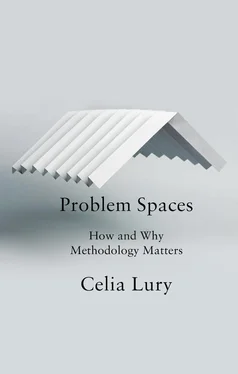Platformization is an ugly neologism, but it is used here to acknowledge both the proliferation of (methodological) platforms and the way in which platforms are not usually discrete or self-contained but are interconnected in a variety of ways, often coming to be embedded in the epistemic infrastructure. Indeed, the ugliness of the term directs attention to the fact that the distinction between platforms and infrastructure is not easy to draw. As Plantin et al. (2016) observe, it is now not uncommon that platform-based services acquire characteristics of infrastructure, while both new and existing infrastructures are increasingly being built or reorganized on the logic of platforms. This logic is important, so it will be argued, because platforms have the capacity to bring together – and modify – the changes in the epistemic infrastructure just outlined, although they by no means contain or exhaust them. They do so through the ways in which they enhance specific formal properties of circulation (Appadurai 2013), specifically those associated with recursion, and in doing so facilitate specific ways to identify and create continuity in the transformation of problems in relation to changing contexts. It is argued that in this way platformization reconfigures the potential afforded by relations between a problem and a problem space, expanding the methodological possibilities of the double force of methods, by creating a boundary infrastructure (Bowker and Star 2000). In doing so, it will be argued, platforms mutate the topologies of knowledge of problem spaces.
The structure of the book
As indicated above, the book aims to address the shifting relationships between knowledge, ignorance and power by developing the concept of problem space. It does this by exploring the inter-relationship of problem spaces and the contemporary epistemic infrastructure in which the composition of problem spaces takes place. To explicate the significance of this inter-relationship, the book is divided into: this Introduction, three Parts, and a Conclusion. Each of the Parts starts from a different point of view on the inter-relationship between problem space and infrastructure, allowing for a shifting – parallax – analysis of the possibilities afforded to a compositional methodology today. Such a structure, while complicated, is necessary since as Martin Savransky so nicely puts it:
… problems have an existence of their own, a mode of existence that is never just immanent to thought, but to a historical – which is to say, processual – world; as such, they can never be reduced to a matter of human psychology, epistemology, or methodology. Problems, in other words, are not that which a certain mode of thinking or knowing encounters as an obstacle to be overcome, but that which sets thinking, knowing and feeling into motion. (2018: 215)
The first Part has only one chapter. It introduces the heuristic of problem spaces through a discussion of five rather disparate writers – John Dewey, Herbert Simon, Donna Haraway, François Jullien and Arjun Appadurai. The aim is to situate compositional methodology, understood as the inter-linking of the formation and transformation of a problem across a problem space, in relation to established methodological approaches.
The second Part has three chapters ( Chapters 2, 3and 4). Chapter 2describes some of the most significant changes in the contemporary epistemic infrastructure and the new possibilities they afford for configuring problem spaces. Chapter 3, co-authored with Ana Gross, considers some of the ways in which variation in price is measured, including the Consumer Price Index. This discussion of methods in practice highlight the methodological possibilities of some of the changes described in the previous chapter. This chapter also introduces the idea that these changes are being accelerated by a process of platformization, and begins to describe the implications of this process for the composition of problem spaces. Chapter 4further develops the idea that we are witnessing the platformization of the epistemic infrastructure through a detailed discussion of the four understandings of platform identified by Tarleton Gillespie (2010): architectural, political, computational and figurative.
Focusing on compositional methodology, the third Part comprises two chapters ( Chapters 5and 6). Chapter 5introduces some of the challenges – what I describe as the double troubles – associated with the methodological possibilities stemming from platformization including: the natively artificial character of the empirical; the multiplicity of the epistemological object; and the genus of cognitive syndromes that, following Gregory Bateson (1972), are described as transcontextualism. Chapter 6situates compositional methodology in relation to the account of Mode 2 knowledge production developed by Helga Nowotny, Michael Scott and Michael Gibbons and others (Gibbons et al. 1994; Nowotny et al. 2001), noting shared concerns as well as differences in emphasis by drawing on the concept of the interface. This concept is deployed to develop the argument that contemporary science is neither external nor internal to society, adding to the analysis of the topological characteristics of today’s problem spaces. As part of a consideration of the accountability and autonomy of knowledge production, it also paves the way for the proposal that methods are being operationalized as part of a cultural imaginary of know-ability, and highlights the dangers of the gamification and weaponization of methods. The chapter contrasts know-ability and answer-ability and ends by outlining an ethics for a compositional methodology in terms of care, and the values of response-ability.
The Conclusion looks back at and reflects on the book’s account of contemporary topologies of knowledge and power.
Before embarking on this journey, it may be helpful to make a couple of observations about some of the assumptions that inform the book. The first is that the book’s understanding of compositional methodology deploys an understanding of methods as practices. In some ways, such an understanding seems too obvious to need stating: in everyday as well as methodological uses, a method is a procedure or process for attaining an object, a way of doing things. But in some accounts, methods are only discussed before or after they are put to work – described in textbooks as a set of techniques to be learnt and then applied or in articles and monographs as completed actions that led to findings. 8Rather than adopt this approach, the book emphasizes the doing or practice of methods to make visible the work that goes into the accomplishment of epistemological values. As Andrea Mubi Brighenti puts it, while being regulatory ideals, these accomplishments are also ‘peculiar creations, … bounded and contingent practices aimed to stabilize certain courses of action and interaction patterns’ (2018: 24). Recognizing that epistemological values emerge from the doing of methods as material-semiotic practices enables a recognition of the composite nature of methodological exploration; for example:
Calculation thus appears as not merely mathematical or metrical in nature, but rather as a composite work made of different stages including objectification, separation, individualization, comparison, association, transformation, disembedding and distribution. (Brighenti 2018: 24)
As the book proceeds, what becomes apparent (hopefully) is that this doing, the compulsion of composition, comprises not only the intended actions of researchers, but also the actions and operations that are proposed, engaged, activated and (sometimes) automated in the epistemic infrastructure. And such actions and operations are themselves embedded in distributed activities that are not necessarily, indeed are not often, guided by epistemological concerns.
Читать дальше











